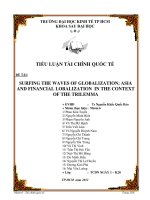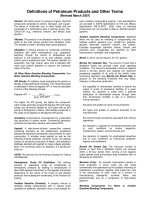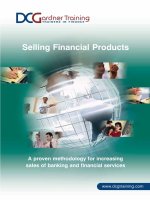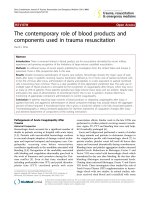3 cross selling of banking products and financial services
Bạn đang xem bản rút gọn của tài liệu. Xem và tải ngay bản đầy đủ của tài liệu tại đây (385.68 KB, 25 trang )
CROSS SELLING
OF
BANKING PRODUCTS & FINANCIAL SERVICES
-by
Gazal Badlani
Ashok Sarkar
PGDM 2010-12
Trimester – 4
Introduction
• Selling of banks products/services to an already
existing customer
• Cross-selling stands for being able to offer to the
existing bank customers, some additional banking
products, with a view to expand banking
business, reduce the per customer cost of
operations and provide more satisfaction and
value to the customer and higher per customer
earning.
Scope of cross selling
• Liability side
• Asset side
Examples of cross selling
1. Credit insurance
2. Life insurance enhancements to traditional
mortgages
3. Auto and homeowners insurance
4. Medical savings accounts
5. Asset management accounts
Importance
• Research statistics demonstrate that the
average customer uses less than two services
from any one depository institution
• Seventy percent of all customers share their
banking needs with more than one financial
institution
Tools Enablement
Ways:
• Phone banking
• Web
• Walk in
Tools:
•
•
•
•
CRM techniques
Referral tracking
Sales call tracking
MIS systems (activity management, information)
7 - steps
Marketing facets
7 times expense
Strong commitment to customer care at all levels
Promises made must be realistic and achievable
Intimate knowledge of the customer leads to excellent
customer service
Continuous feed back from the customers
7 steps approach
Cross selling & Relationship Banking
•
•
•
•
The emphasis here is on viewing the customer as a long term business
relationship
Banks plan to meet the total banking requirement of the customers and
expect repeat business
Relationship is based on full knowledge about the customer needs and
causing total customer satisfaction by providing services that exceeds his
expectation
An understanding of exactly what the customer is buying in critical. The
basic utility he derives from the product is the nucleus of core in the
center, surrounded by services of both tangible and intangible attributes
7 steps model of relationship banking
7 step model approach
7 step model approach
1. On super - ordinate goal: Draw the vision and mission
2.
3.
statements around the customer value
Strategy - Draw a strategy of market segmentation to focus on a
customer
On structure - Restructure the organization as a cross functional and
process oriented one
System - Design a service delivery system on quality and coordination
4.
5. On skill - Cultivate skill as cutting edge
6. On style - Devise a suitable appraisal system and reinforce it through
top management
7. On staff - Devise policies which empower staff and encourage open
communication
7 steps model of personal selling
1.
2.
3.
4.
5.
6.
7.
Prospecting & qualifying
Pre-approach (deciding the best approach)
Approach (ability to observe and listen)
Presentation
Handling objections
Closing
After sales service and follow up
Bundling
Cross selling process
Buying cycle
NPTB modeling
The challenge of cross selling is to know
which product to sell to which customer
NPTB modeling
A next product to buy modeling promises to
enhance the effectiveness of cross selling by
specifying which product to sell to which
customer
NPTB approach
1.
2.
3.
4.
Compiling data
Selecting statistical method
Estimation and evaluation
Scoring and targeting approach
Benefits
1. Develop a true dialogue with each customer
2. Knowing the ins and outs of the product
offerings
3. Propose appropriate solutions
4. Capture data and share it across enterprise
5. Create incentives around effective cross
selling
6. Recognize all opportunities for cross selling
Bottom line & Implementation
The biggest difference between "merely
effective" and "high performing" cross-selling in
financial services is the degree to which the high
performers invest the time to really understand
customers' needs.
Problems
• The banker as a consultant
• Who owns the client
• Dislodging a satisfied client
Thank You









